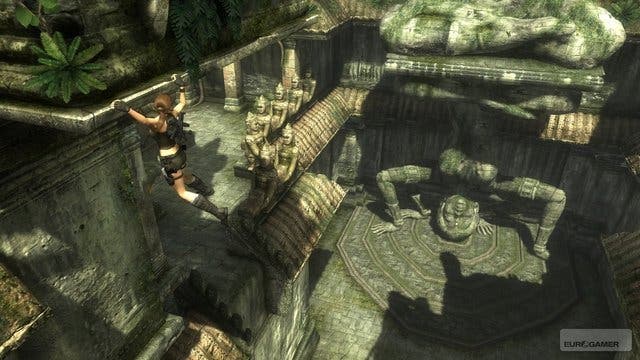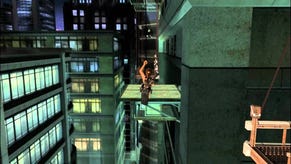Tomb Raider Underworld
If I had a hammer.
Advance warning: Terry Nutkins - I'm struggling to think of a more relevant wildlife personality, but my brain appears to be wedged in 1986 - is not going to enjoy this very much, but presumably he didn't enjoy any of Tomb Raider's previous PETA-offending outings either, and at least this time he gets the optional use of a tranquiliser gun.
Elsewhere, the promised dual targeting system is working well, and seems for the most part to take care of itself, choosing its lock-ons fairly intelligently. It's tempting to argue that the famously iffy Tomb Raider aim has been tightened up somewhat, although the reticule does still twitch around like a methadone addict when there's a lot going on. Besides that, the Adrenalin Moments are returning for this outing: slo-mo bursts with a timing twist, they allow you to take out enemies quickly with suitably cinematic grace, or fail spectacularly and end up back-flipping painfully into a wall instead.
With the combat looking promising, it's on to the world of locks, keys, and movable blocks, where the improved range of moves, and a few handy gadgets mean that Underworld is promising a much tighter blending of puzzle and environment than previous games have been able to offer. From an item that allows you to manipulate huge pieces of the scenery, including entire walls, to freshly devious implementations of the grapple, the challenges are looking balanced, mysterious, and quietly sadistic.
And at least one of them looks like an old friend, too. Towards the end of the demo, I'm shown a puzzle from the Mexico section of the game, a fresh take on the legendary St Francis' Folly sequence from the very first Tomb Raider. A multi-key fan favourite, it consists of a handful of themed rooms, all with a deadly surprise inside, leading out from a central hub.

The easy referencing of an aging classic seems to suggest that, if there's a flaw in Underworld's design, it may be that Crystal Dynamics are offering up a kind of platforming Greatest Hits. But exploring the puzzle itself confirms that there's far more at work than simple homage. Each room provides you with a clear target, and then swiftly scuppers your initial strategy for reaching it, often rather unpleasantly. The twists are often brilliantly unexpected, and while they feature series staples like rotating blades and falling rocks, they put the old machinery to use in surprising new ways.
The eventual solutions are often disarmingly simple, but extremely hard to reach - either due to precision timing challenges, tricky combinations of moves, or those familiar logic roadblocks where you simply can't see a way of progressing until you realise the answer's been staring you in the face all along. You're going to tear some of your hair out on Underworld, and you're also going to be squished, chopped in half, and impaled a fair few times, too, but you're going to end up doing some heavy-duty problem-solving along the way, and the fact that there are now multiple ways of tackling most puzzles means, despite the challenge, there's significantly less likelihood that you'll be sent scampering off to the nearest FAQ.

Building on its existing template, providing a handful of new features and a great deal of calculated nastiness in its puzzle design, Tomb Raider: Underworld seems to be coming together in a very promising fashion. With LittleBigPlanet and Mirror's Edge providing fresh new directions for platformers this Christmas, it's only fitting that one of the stalwarts of the genre should be on hand to prove that there's plenty of fun to be had with the classic template. The most surprising thing about Underworld then, might not be the plot twists or revelations, but the suggestion that the traditional platform game may not be dead just yet - and even if it is, you can still have a pretty good time in its tomb.
Check back next week for our most recent impressions of Tomb Raider: Underworld, which is due out for Xbox 360, PS3, Wii, PC, PS2 and DS on 21st November.



